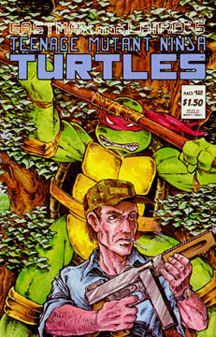Coming off what I like to call the “Original 16” of Mirage “Teenage Mutant Ninja Turtles” Volume 1— Issues 1-11 plus the five one-shots – I had a few questions: Most notably, how is the Shredder alive? But also, I hoped that the writers would delve more into Splinter (who never got a one-shot): Did he feel guilty at all for bringing the Turtles, April and Casey into his personal feud with the Foot Clan?
Judging by his conclusion in Issue 11 that April has gained more than she has lost, I guess not. But Splinter can’t really be that self-centered, can he?) And I wanted to know what was up with humans (General Blanque’s Federation in the Triceraton arc) who speak English but have never heard of Earth.
If you had those questions, too, welcome to six issues of frustration in No. 12-15 and 17-18. (I’m skipping Mark Martin’s overtly comedic and non-canonical 16 and 22-23; completists can get the scoop on those over at TMNT Entity.) I’m re-reading these stories via the trade paperbacks, but I imagine the letter columns in the original printings are filled with readers asking about the Shredder and the editors pleading for patience.

“Teenage Mutant Ninja Turtles” Issues 12-15, 17-18 (1987-89)
Titles: “Survivalists” (No. 12), “The People’s Choice” (No. 13), “The Unmentionables” (No. 14), “Dome Doom!” (No. 15), “Distractions” (No. 17), “The Shell of the Dragon” (No. 18)
Writers: Peter Laird, Michael Dooney, Kevin Eastman, Eric Talbot, Mark Bode
Pencils: Peter Laird, Michael Dooney, Kevin Eastman, Eric Talbot, Mark Bode
Inks: Peter Laird, Michael Dooney, Kevin Eastman, Eric Talbot, Jim Lawson
Readers ultimately had to wait 1 ½ years for their answers. Admittedly, a case could be made that some downtime was needed between two major showdowns with the Shredder. However, what’s notably odd about these issues – dubbed the “Exile to Northampton” era by TMNT Entity – is that the Turtles don’t even talk about the Shredder or the Foot Clan.
In my judgment, this batch of issues connects three times and whiffs three times.
The strong issues
Issue 12 (“Survivalists”) is the first issue to not have both Eastman and Laird contributing, but Laird does a respectable job on solo duty. The gang’s picnic in the woods outside their farmhouse is interrupted by survivalists, who are frustrated by the stalemate of the Cold War and plan to set off a nuclear bomb. Don disarms a nuclear bomb in the survivalists’ hideout, so technically, he saves the world.
Nonetheless, I see this as a quiet side story; it’s almost peaceful as the Turtles go all “First Blood” on the bad guys, taking them out one by one in the woods. My favorite scene is when Raph and Leo disguise themselves as stepping stones in the river, shells up, then spring forth to take out the baddies.

Issue 14 (“The Unmentionables”) is the first Laird-less Eastman entry, and it’s also a winner, as he puts Casey, April and the Turtles through the paces of a noir mobster mystery. I like the idea that Casey fancies himself a private eye, although I wish there was a bit more at stake here than a brass cow statue. Also, it’s a hard story to follow, but the narrative ambition – and the expansion of Casey’s character — makes up for it. (By the way, Casey delivers what I believe is the first “Cowabunga!” of the series in this issue.)
Ultimately, I have to give a thumbs-up to Issue 17 (“Distractions”) by Eric Talbot and Eastman. Michaelangelo, having been split up from his brothers, goes on a solo mission to rescue a princess in feudal Japan. I read the whole story thinking “How is this possible? Last I checked the Turtles were in 20th century America.”
The last page makes it work, though, as we see that Mikey was writing this story on pen and paper, with Klunk as his audience. It’s just good enough to be entertaining, but certainly clichéd enough to believe it came from novice wordsmith Michaelangelo (who will hone his skills more in Volume 3). I wonder if – in retrospect – E&L should’ve had Mike rather than Don pounding away at the typewriter in Issue 11?
The weak issues
And now for the three misfires. With Issue 13 (“The People’s Choice”), Michael Dooney becomes the first writer other than E&L to pen a “TMNT” issue. It’s also the first issue with no E&L art. Dooney was part of the art team on Issue 9, but there he mimicked E&L’s grittier style. Now we see that he prefers clean lines when going solo; indeed Dooney would go on to create a lot of beautiful TMNT art through the years, particularly as a painter.
My problem is with the story: A good space-faring warrior woman crash lands right where the Turtles are camping, then her enemy and alien henchmen land and a fight ensues, with the Turtles helping the side of good. As with the Triceraton arc, we meet extraterrestrial humans who speak English but haven’t heard of Earth. Is this a part of the “TMNT” mythos that will never be explained?
For Issue 15 (“Dome Doom!”), it’s back to Laird, who introduces the Justice Force, a Northampton-based group of superheroes who bear a similarity to the Fantastic Four. While I don’t mind aliens or other mutants in “TMNT,” I think it cheapens the specialness of the saga to have other superhero groups wandering around in it. Obviously, Laird disagrees.
While it’s possible that “Dome Doom!” was intended as a superhero parody or a commentary on accusations that E&L sold out by licensing “TMNT” to TV and movie incarnations, other superheroes such as these would unfortunately pop up as the Mirage saga moved forward, especially in Laird’s Volume 4. Image’s Volume 3 also had more superheroes than I would’ve liked.
Issue 18 (“The Shell of the Dragon”) is primarily by guest writer Mark Bode, but Eastman chips in on the story, so I opted not to skip it on this re-reading. Following Martin’s Issue 16, Bode is the second non-Mirage scribe to tackle an issue. While the style is wildly different, with the word bubbles appearing above each panel rather than within them, the story isn’t very good considering the 40-page count – a Chinese restaurateur family feuds with local gangsters and the Turtles help out.
It’s inexplicable on so many levels (money, for one) that the Turtles could or would travel by boat to China on a vacation. If this story had been set in New York’s Chinatown, it might’ve worked, but as it stands it doesn’t seem to fit with the continuity and it’s bizarre that Eastman contributed to it.
Readers in 1989 probably were scratching their heads at this strange stretch of issues, too. Perhaps they even worried that E&L had not only let other folks take the reins of the “TMNT” cartoons and movies, but also the Mirage storyline that had been on a nice roll up through Issue 12. Luckily, order would be restored in Issue 19.

